
Acraea acrita, the fiery acraea, is a butterfly of the family Nymphalidae. It is found in large parts of Africa.

Acraea cepheus, the Cepheus acraea, is a butterfly of the family Nymphalidae. It is found in Africa, from Nigeria and Angola to Uganda, western Tanzania and Zambia.

Bematistes aganice, the wanderer, is a butterfly of the family Nymphalidae. It is found in southern and south-eastern Africa.

Acraea anemosa, the broad-bordered acraea, is a butterfly of the family Nymphalidae which is native to southern Africa and coastal East Africa.

Acraea nohara, the light red acraea, is a butterfly of the family Nymphalidae. It is found from KwaZulu-Natal north through Zimbabwe to Kenya.

Acraea cabira, the yellow-banded acraea, is a butterfly of the family Nymphalidae that is native to Africa.

Acraea esebria, the dusky acraea, is a butterfly of the family Nymphalidae from southern and eastern Africa.

Acraea zetes, the large spotted acraea, is a butterfly in the family Nymphalidae which is native to sub-Saharan Africa.

Bematistes epaea, the common bematistes, is a butterfly in the family Nymphalidae. It is found in Senegal, Guinea-Bissau, Sierra Leone, Liberia, Ivory Coast, Ghana, Togo, Benin, Nigeria, Cameroon, Equatorial Guinea, the Republic of the Congo, Angola, the Democratic Republic of the Congo, Sudan, Ethiopia, Uganda, Kenya, Tanzania, Malawi and Zambia.

Bematistes tellus, the orange bematistes, is a butterfly in the family Nymphalidae. It is found in Nigeria, Cameroon, Equatorial Guinea, the Republic of the Congo, the Democratic Republic of the Congo, Uganda and Tanzania.
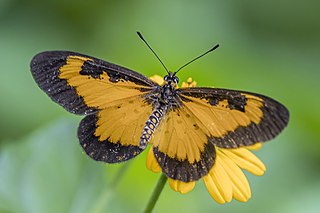
Acraea acerata, the falls acraea or small yellow-banded acraea, is a butterfly in the family Nymphalidae. It has an extensive range in sub-Saharan Africa.

Acraea althoffi, the Althoff's acraea, is a butterfly in the family Nymphalidae. It is found in Cameroon, Gabon, the Democratic Republic of the Congo, the Central African Republic, Uganda, Kenya and Tanzania.
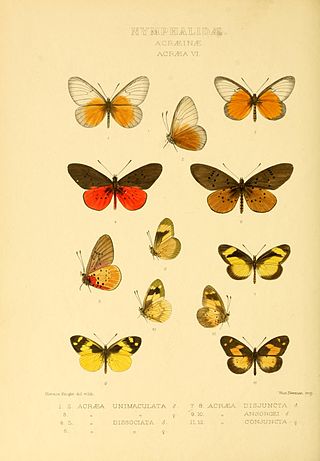
Acraea ansorgei is a butterfly in the family Nymphalidae. It is found in Kenya, Uganda and the Democratic Republic of the Congo.

Acraea iturina, the Ituri glassy acraea, is a butterfly in the family Nymphalidae. It is found in Nigeria, from Cameroon to the Democratic Republic of the Congo and in Uganda, Tanzania and Ethiopia.

Acraea jodutta, the jodutta acraea, is a butterfly in the family Nymphalidae. It is found in Guinea, Sierra Leone, Liberia, Ivory Coast, Ghana, Togo, Nigeria, Cameroon, Equatorial Guinea, São Tomé and Príncipe, Gabon, the Republic of the Congo, the Central African Republic, Angola, the Democratic Republic of the Congo, Sudan, Uganda, Kenya and Ethiopia.

Acraea orestia, the Orestia glassy acraea, is a butterfly in the family Nymphalidae. It is found in Ivory Coast, Ghana, Togo, Nigeria, Cameroon, Equatorial Guinea, Gabon, the Central African Republic, Angola, the Democratic Republic of the Congo, Uganda, Kenya and Tanzania.
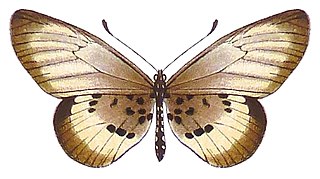
Acraea peneleos, the Peneleos acraea, is a butterfly in the family Nymphalidae, which is native to the tropics and northern subtropics of sub-Saharan Africa.
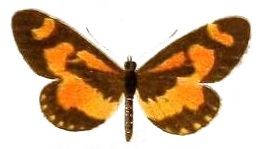
Acraea sotikensis, the Sotik acraea, is a butterfly in the family Nymphalidae which is native to the African tropics and subtropics.

Acraea parrhasia, the yellow-veined acraea, is a butterfly in the family Nymphalidae which is native to sub-Saharan Africa.
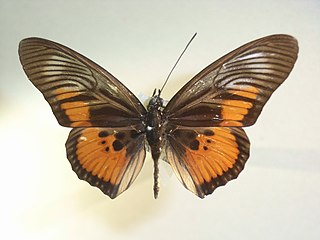
Pseudacraea clarkii, or Clark's false acraea, is a butterfly in the family Nymphalidae. It is found in Nigeria, Cameroon, Gabon, the Republic of the Congo, the Democratic Republic of the Congo and western Uganda.



















